Groundbreaking Food Gardens: Breaking Out of the Raised-Bed Box
Growing your own vegetables in your garden doesn’t mean you have to sacrifice design. Author Niki Jabbour explores how to grow an edible garden without sacrificing garden aesthetics in her book Groundbreaking Food Gardens.For the design-oriented gardener, growing your own vegetables brings to mind a functional but dull row of neatly-planted rectangular raised beds. While they certainly work for growing high-yield vegetables, these boxy garden standbys are like the broccoli of the design world: nutritious but lacking in panache. With food gardening’s resurgence in popularity, savvy gardeners are looking for ways of growing vegetables without sacrificing aesthetics.
In Niki Jabbour’s book, Groundbreaking Food Gardens, she profiles 73 plans from landscape designers and accomplished vegetable gardeners that bring together both form and function. We spoke with Jabbour to get an inside look at five of the enticing edible garden designs featured in her book.
Marjorie Harris’ Partially-Shaded Checkerboard
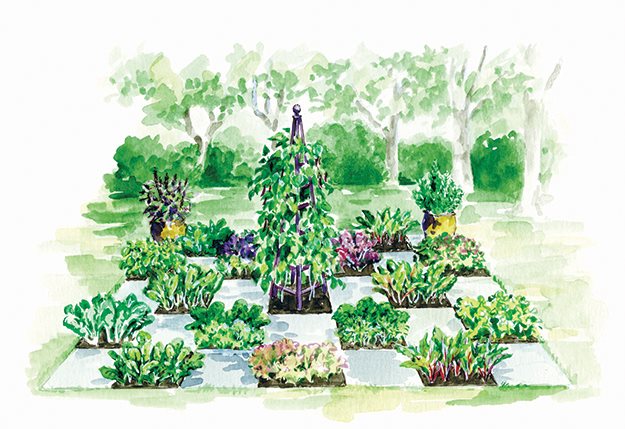
Illustration by Elayne Sears
When confronted with shade, many would-be edible gardeners give up before they even start. However, famed Toronto gardener Marjorie Harris created a fresh, modern checkerboard design that offers the light-challenged gardener more than just good looks. “The light-colored pavers reflect light, giving plants a boost,” says Jabbour. “They also absorb heat throughout the day, so they help stretch the growing season by keeping the soil warm.”
With an obelisk at the center and pots set towards the back for vertical interest, this flexible garden plan can be amended for small or large gardens. Square, 2-by-2-foot pavers are set on sand, with 2-foot garden plots in between. Harris suggests planting shade-tolerant leafy crops like kale, spinach, lettuce, beets, Asian greens, and Swiss chard, which can thrive with as little as 3 to 4 hours of sun per day. Another advantage to this patterned approach is that the pavers give you something to kneel on when tending the plot.
Amy Stewart and Designer Susan Morrison’s Cocktail Garden
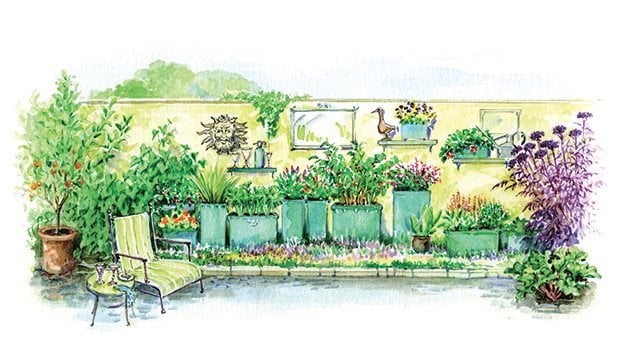
Illustration by Mary Ellen Carsley
When author Amy Stewart began researching her book, The Drunken Botanist, she quickly realized she needed a place for the dozens of obscure cocktail ingredients she now wanted to grow. However, the narrow side yard off the kitchen was only 7 feet wide in some places, presenting a challenge: how would she make this almost-unusable strip into a cocktail garden where people would want to hang out? Designer Susan Morrison was up for the task.
Morrison specified a series of unfinished wood containers in varying sizes and shapes to provide upright interest with a small footprint. The containers were painted, making it easy to keep to the blue-green color scheme, and the larger planters became home to more sizable plants such as columnar apple trees and calamondin citrus. Stewart hung framed mirrors and windows on the wall to make the space feel more expansive. Jabbour says, “I love how this shows that good design doesn't have to cost a lot. They painted inexpensive wood containers, then upcycled pallets, mirrors, and other decor. The results are both gorgeous and attainable.”
Debra Prinzing’s Edible Cutting Garden
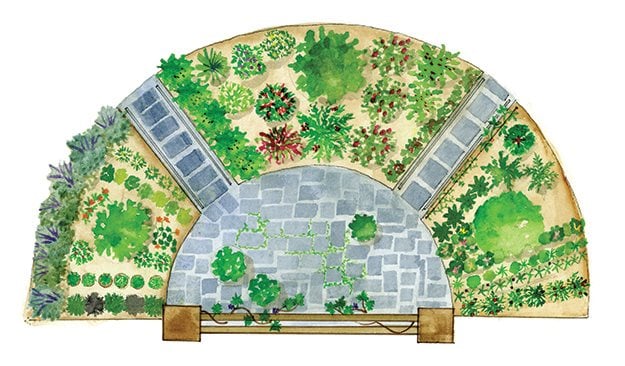
Illustration by Mary Ellen Carsley
The “slow flower” movement, of which Prinzing is a pioneer (Slow Flowers: Four Seasons of Locally Grown Bouquets from the Garden, Meadow and Farm), introduced her to the delights inherent in using edibles in a vase. Pea tendrils, raspberries and blueberries, herbal plants such as rosemary and lemon verbena, and the dramatic leaves of rhubarb and artichoke are just some of the edible plants that work beautifully for cutting. She even recommends using edible flowers and food from the garden to craft a snackable centerpiece for the table, as long as your garden is organic.
With edibles chosen for their ornamental qualities, a little structure is all that’s needed to pull this backyard design together. A half-circle patio of tumbled bluestone is surrounded by a 6-foot-deep crescent-shaped border. Stepping-stone pathways divide the garden into three sections: a fruiting garden in the center with dwarf trees, shrubs and berries, flanked by an herb garden and a vegetable garden on either side. Jabbour vouches for the pleasures an edible cutting garden can bring. “I love using chive flowers in a bouquet, and after the party’s over, I can toss them in a vinegar to make a pale-pink, onion-flavored vinegar,” she says.
Rachel Mathews’ Culinary Courtyard
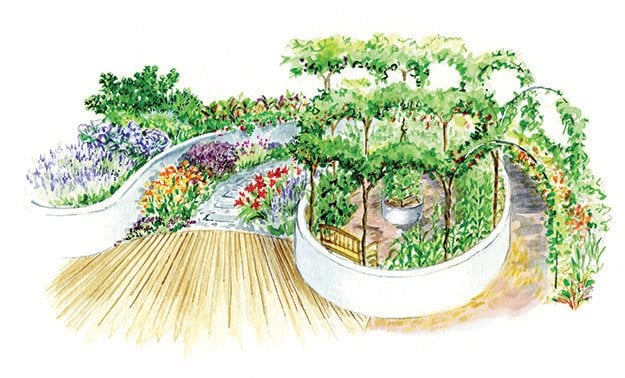
Illustration by Mary Ellen Carsley
International garden designer Rachel Mathews specializes in creating contemporary gardens for small spaces. In this graciously curved design, she’s created an urban sanctuary with a circular wooden deck, a private brick seating area within the low garden wall, and an inviting series of pathways to encourage visitors to stroll throughout and enjoy the fragrances and flavors of the seasons. Circular shapes, Matthews notes, are helpful in small gardens because your eyes follow the curves, which makes the space feel more expansive.
Eight-foot-tall metal arches support dwarf fruit trees and vining crops. This height balances the look of the design, and creates interest by preventing the entire garden from being seen in one go. New gardeners may wonder whether pruning fruit trees over an arch is difficult, but Jabbour is reassuring. “Espaliered fruit trees always look incredibly intimidating, but I think they are even easier to prune than a full-size tree,” she says. The dwarf varieties put out less growth, and the architectural framework makes it clear which branches should be removed for the best form.
Nan Sterman’s Water-Wise Edibles and Herbs
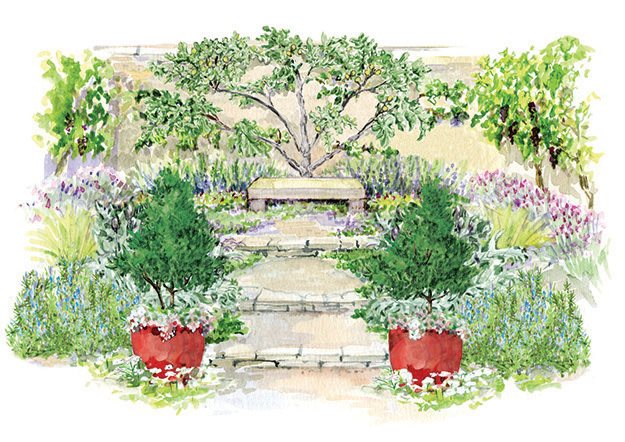
Illustration by Elayne Sears
Water-wise gardening expert Nan Sterman focuses her gardening efforts on plants that are adapted to her dry San Diego climate, and combines smart plant selection with mulching, drip irrigation, and clever container planting techniques to avoid wasting this resource. Highly efficient drip irrigation directs water exactly where it is needed, and a 3-inch-thick layer of mulch over the drip line keeps water from evaporating out of the soil. Containers, a notoriously water-hungry form of planting, are kept xeric by using a cylinder of DriWater, a water-retaining gel comprised of food-grade ingredients which helps keep plants moist, within each pot.
Most low-water edibles originate from Mediterranean climates, where rainfall is limited. Figs, grapes, and artichokes, plus herbs such as oregano, thyme, rosemary, and bay round out this fragrant and attractive multi-tiered space. Jabbour exclaims, “Who wouldn't love to walk through this garden and pick a bouquet of herbs for marinating chicken?” Sterman’s is an ideal design for those who don’t want the commitment of replanting vegetables every year, but still want to feel the connection that comes from garden-to-table living.
Though vegetable gardening beds have long been seen as a worthy but unstylish part of the garden, there’s no reason they can’t be enveloped into the fold of a beautifully-landscaped space.
Featured in: Garden Design's Top 10 Garden Trends for 2024 ("Enhancing Your Garden With Edimentals")
RELATED:
How to Start a Vegetable Garden
How to Start an Herb Garden
Companion Planting
Garden Design is reader-supported. When you purchase products through links on our site, we may receive an affiliate commission.

